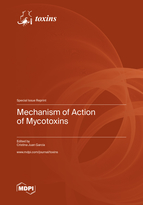Mechanism of Action of Mycotoxins
A special issue of Toxins (ISSN 2072-6651). This special issue belongs to the section "Mycotoxins".
Deadline for manuscript submissions: closed (30 April 2023) | Viewed by 28765
Special Issue Editor
Interests: Toxicity of mycotoxins
Special Issues, Collections and Topics in MDPI journals
Special Issue Information
Dear Colleagues,
Mycotoxins are a diverse group of chemicals that present wide toxicological responses in animals and humans. Their ingestion causes toxic effects that go from acute toxicity to long-term or chronic health disorders. Some mycotoxins have caused outbreaks of human toxicoses, and at least one mycotoxin, aflatoxin B1, is an assumed human hepatocarcinogen. As part of a comprehensive effort to curtail the adverse health effects posed by mycotoxins, substantial research has been conducted to determine the mechanism of action of mycotoxins. Although much information has been obtained regarding the action of several mycotoxins, future research topics should continue to address several areas of critical concern.
Detection of biomarkers in noninvasive samples, such as urine, requires the use of methods which are beginning to become an important tool in the measurement of human exposure to mycotoxins in populations that are particularly at risk. Among that, proteomics, metabolomics and genomics are actually goals in toxicological research not only for their innovative methodologies but also because they can reveal changes in the levels of abundance of proteins and metabolites and their interactions.
In vitro studies in different cell lines could detail and explain many of these mechanisms, while in vivo can give a real scenario in the development of a toxic effect.
The focus of this Special Issue of Toxin is to gather the most recent reports on the mechanism of action of mycotoxins on single or combined mycotoxins studied in vivo or in vitro, the identification of known and unknown mycotoxins metabolites and other metabolites in different cell lines and animals or matrices (including organs, urine, or blood), and the development of analytical skills to study these mechanisms. Research papers and review articles describing novelties or overviews, respectively, are welcome.
Prof. Dr. Cristina Juan García
Guest Editor
Manuscript Submission Information
Manuscripts should be submitted online at www.mdpi.com by registering and logging in to this website. Once you are registered, click here to go to the submission form. Manuscripts can be submitted until the deadline. All submissions that pass pre-check are peer-reviewed. Accepted papers will be published continuously in the journal (as soon as accepted) and will be listed together on the special issue website. Research articles, review articles as well as short communications are invited. For planned papers, a title and short abstract (about 100 words) can be sent to the Editorial Office for announcement on this website.
Submitted manuscripts should not have been published previously, nor be under consideration for publication elsewhere (except conference proceedings papers). All manuscripts are thoroughly refereed through a double-blind peer-review process. A guide for authors and other relevant information for submission of manuscripts is available on the Instructions for Authors page. Toxins is an international peer-reviewed open access monthly journal published by MDPI.
Please visit the Instructions for Authors page before submitting a manuscript. The Article Processing Charge (APC) for publication in this open access journal is 2700 CHF (Swiss Francs). Submitted papers should be well formatted and use good English. Authors may use MDPI's English editing service prior to publication or during author revisions.
Keywords
- proteomic
- metabolomics
- genomic
- mycotoxin
- in vitro
- in vivo
- q-TOF
- biomarkers
- mechanism







